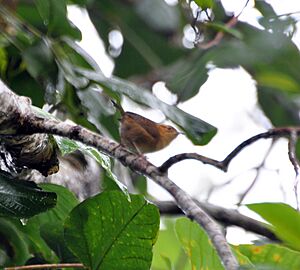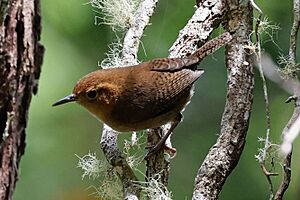Ochraceous wren facts for kids
Quick facts for kids Ochraceous wren |
|
|---|---|
 |
|
| In Costa Rica | |
| Conservation status | |
| Scientific classification | |
| Genus: |
Troglodytes
|
| Species: |
ochraceus
|
 |
|
The ochraceous wren (Troglodytes ochraceus) is a tiny songbird that belongs to the wren family. You can find these birds living and raising their young in Costa Rica, Panama, and Colombia.
Contents
About the Ochraceous Wren
Scientists group living things into families and species. The ochraceous wren is part of the wren family. For a while, some scientists thought it was a type of mountain wren.
Today, most experts agree it is its own species. Different groups of scientists recognize slightly different types, or "subspecies," of the ochraceous wren. These subspecies have small differences in their looks or where they live.
What Does the Ochraceous Wren Look Like?
The adult ochraceous wren is quite small. It is about 9.5 to 10 centimeters (3.7 to 3.9 inches) long. It weighs only about 8 to 10 grams (0.28 to 0.35 ounces). That's about the weight of two quarters!
This bird has a rich brown color on its head and back. Its lower back has a reddish-brown tint. The tail is brown with dark stripes. A bright yellowish stripe goes above its eye, reaching back to its neck. This stripe is called a supercilium.
Its chin, throat, and upper chest are a buffy brown color. The lower chest and upper belly are a lighter, buffy white. The sides and lower belly are a darker buffy brown. Some subspecies might be a bit duller or have a larger bill.
Where Do Ochraceous Wrens Live?
Ochraceous wrens live in the highlands of Costa Rica and Panama. Some are also found in northwestern Colombia.
These birds prefer wet mountain forests. They especially like areas with many epiphytes. Epiphytes are plants that grow on other plants, like mosses and ferns on tree trunks. You can also find them in places like forest edges or pastures with trees.
They usually live at elevations between 900 and 2,450 meters (2,950 and 8,040 feet) above sea level. Sometimes, they are seen as low as 600 meters (1,970 feet) or as high as 3,000 meters (9,840 feet).
Ochraceous Wren Behavior
How They Find Food
The ochraceous wren mainly looks for food on mossy tree trunks. They also search within the epiphytes growing on trees. Their diet consists of small invertebrates, which are tiny creatures without backbones, like insects.
Reproduction and Life Cycle
In Costa Rica, ochraceous wrens seem to build their nests from April to July. One researcher found three nests. All of them were built inside a big clump of epiphytes and plant debris. These nests were hanging from a branch, about 12 to 15 meters (40 to 50 feet) above the ground. Families with two adult birds and two young ones have been seen.
Their Song and Calls
The ochraceous wren has a soft and varied song. It sounds like a mix of liquid trills and high, thin whistles. They also make calls that sound like a rolling, high-pitched "peeer" or "peeew." Sometimes, they make a low, weak "churr" sound.
Conservation Status
The IUCN (International Union for Conservation of Nature) has listed the ochraceous wren as a species of "Least Concern." This means they are not currently in danger of disappearing.
Even though scientists haven't counted their exact population, they believe the bird is quite common. It lives in several national parks and special protected areas. This helps to keep their habitats safe.



